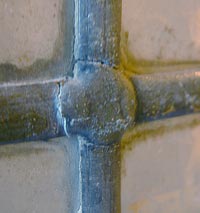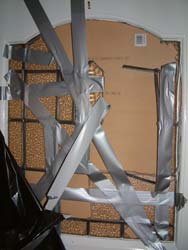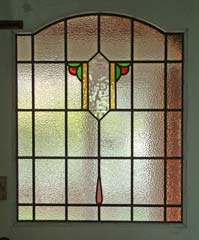 |
|
|||||||
All content is
© Lady Bay Art Glass. Reproduction in whole or part is not permitted.
Whilst we understand that it is possible to copy anything on this site we ask that you only do so for your own immediate viewing and that if you want to use parts of this site for other purposes you should ask our permission first.
 |
Signs of impending doom!!! Lead cracking. |
A large proportion of our work is the repair and restoration of all types of leaded lights. Panels in doors suffer because of the jolting they receive from shutting, made the worse by a door that doesn't fit very well, by slamming in windy weather or by teenagers going 'OUT'. They become bowed, and the lead shows signs of work hardening and cracking.
The cement that seals between the lead and the glass has for many years (possibly centuries) been linseed oil based. When fully set this is a hard impervious 'glue' that hold the panel together and provides rigidity and strength to the panel. With age the cement becomes brittle and repeated shock cracks it until eventually it breaks down to powder. At this point the panel becomes very wobbly and you will notice small cracks in the lead adjacent to the solder of the joints in the centre of the panel. Left alone the panel will carry on deteriorating until it eventually falls out. If it is in a fixed opening the cement will last a lot longer but eventually it will become eroded and the panel will probably leak before it starts to wobble. Panels can deteriorate at different rates and this is principally determined by how the panel is treated, so it is important to ensure that doors do not stick and that locks don't require a good tug to shut the door. Likewise with windows.
 |
A panel in dire need of rescue. |
The remedy to the above problems is to rebuild the panel re-using the glass and reassemble the pieces with new lead. Often we are asked to fit a reinforcing bar instead of rebuilding but this is always a false economy. Since the underlying structure is defective this will only delay the inevitable and wont last as long as the owner would like it to. Similarly we are asked to fit a single sheet of clear float glass in front of the panel to stop it bowing outwards, but this, like double glazing a leaded light is aesthetically unappealing (actually it's hideous) and the cost would be better put towards a full restoration instead.
 |
The same panel rebuilt. |
Panels in a quite poor state of repair can be brought back to an 'as new' condition. If glass pieces are broken we often will have some of the glass to cut new replacements or if not there is usually a new substitute that will be quite unobtrusive. If the texture is unusual we can create a reasonable facsimile by slumping a piece of the correct colour glass into a plaster impression of the old texture in order to recreate the original piece.
We always recommend fitting of reinforcing bars to panels over about 9" wide to limit the amount of deflection that occurs when an accidental slam happens. This will extend the longevity of the panel greatly. There is more information about the polished brass reinforcing bars that we employ in the Construction section.
When possible we will do in situ repairs though please don't ask us to do this to an already wobbly panel. It really isn't a good idea and will only have an acceptable lfe in a rigid panel.
